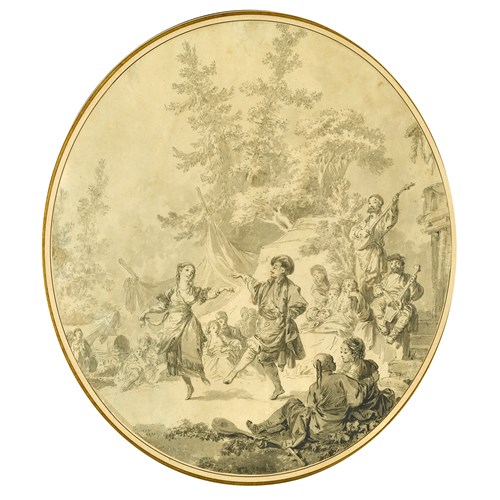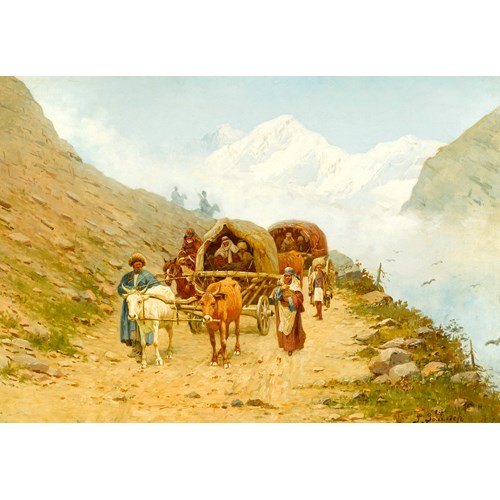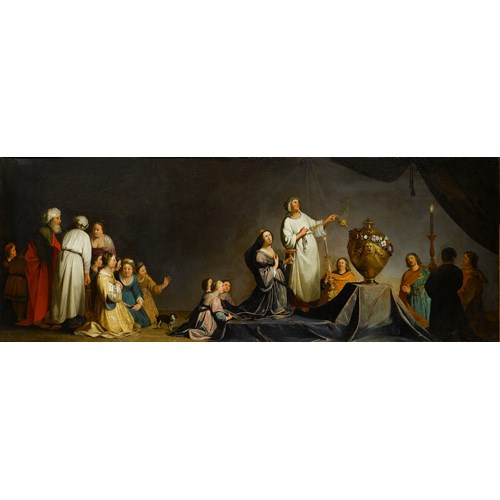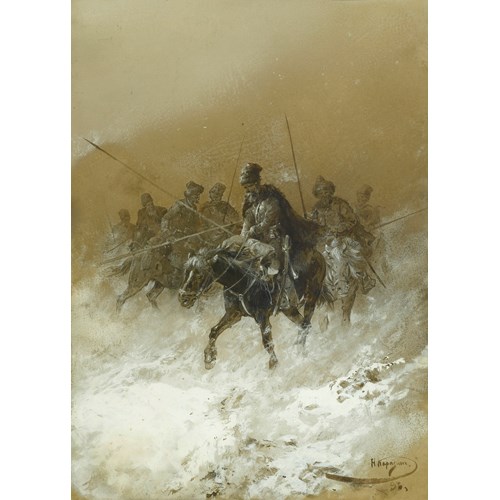Marketplace
A Peasant Family and their Animals among Classical Ruins
Pietro Giacomo Palmieri
A Peasant Family and their Animals among Classical Ruins
Epoque 1750-1850, 18th century
Origine Italy
Medium Black chalk, Pen, Brown ink, Brush
Dimension 36.2 x 54.6 cm (14¹/₄ x 21¹/₂ inches)
Pietro Giacomo Palmieri’s drawing shows a crumbling architectural ruin set in a slightly wild and overgrown landscape. An old lady and child are standing beneath one of the archways whilst a man on a horse, who is guiding sheep and accompanied by a dog and a donkey, looks down on them. The building is short, squat and carved from huge lumps of stone, its imposing form dominating the scene. The ruined state of the structure creates a worn and dilapidated air to the scene, its base is cracked and crumbling, the remnants of the tower above are barely standing, and creepers and plants have begun to take over. The surrounding landscape also contributes to this mood; huge boulders, bare and windswept trees and a dark and stormy sky suggest an atmosphere of untamed nature. This type of rugged and weathered landscape is typical of Palmieri’s work.
One of the most prominent aspects of A Peasant Family and their Animals among Classical Ruins is the range of tonal contrasts that Palmieri has applied to the work. This is a recurring characteristic of Palmieri’s drawings, as evidenced by Landscape with Three Woman Dressing to Leave the Bath. In this work the strong chiaroscuro of the women and animals in the centre of the drawing, achieved by the use of a bright light, is mediated by the variety of tone in the surrounding shadows. Although in A Peasant Family and their Animals among Classical Ruins these contrasts are perhaps not as stark, there is, however, greater variety to them on account of Palmieri’s use of different washes.
Palmieri was born in Bologna, where he studied at the Accademia Clementina di Bologna with Ercole Graziani (1688-1765). He was invited to Parma by Guillaume du Tillot, a leading minister who was trying to make the court a cultural centre. It was in Parma that Palmieri developed his style of landscape, for which he was later to become recognised. His works generally reveal a strong debt to seventeenth-century Dutch art, Italian painters, such as Salvator Rosa (1615-1673) and Guercino (1591-1666), and contemporary French works, particularly those of Claude-Joseph Vernet (1714-1789). Typically, a few rustic figures, possibly with accompanying animals, are often dotted about rugged, isolated landscapes, which have clearly been moulded by the passing of time; a group of these landscapes were engraved and published as Il Libro dei paessaggi in 1760. Having lived in Paris for eight years Palmieri moved to Turin in 1779, where he worked for the Savoy court as an advisor for the royal collection of prints and drawings. He also produced witty trompe l’oeil drawings and accomplished compositions consisting of assemblages of prints.
One of the most prominent aspects of A Peasant Family and their Animals among Classical Ruins is the range of tonal contrasts that Palmieri has applied to the work. This is a recurring characteristic of Palmieri’s drawings, as evidenced by Landscape with Three Woman Dressing to Leave the Bath. In this work the strong chiaroscuro of the women and animals in the centre of the drawing, achieved by the use of a bright light, is mediated by the variety of tone in the surrounding shadows. Although in A Peasant Family and their Animals among Classical Ruins these contrasts are perhaps not as stark, there is, however, greater variety to them on account of Palmieri’s use of different washes.
Palmieri was born in Bologna, where he studied at the Accademia Clementina di Bologna with Ercole Graziani (1688-1765). He was invited to Parma by Guillaume du Tillot, a leading minister who was trying to make the court a cultural centre. It was in Parma that Palmieri developed his style of landscape, for which he was later to become recognised. His works generally reveal a strong debt to seventeenth-century Dutch art, Italian painters, such as Salvator Rosa (1615-1673) and Guercino (1591-1666), and contemporary French works, particularly those of Claude-Joseph Vernet (1714-1789). Typically, a few rustic figures, possibly with accompanying animals, are often dotted about rugged, isolated landscapes, which have clearly been moulded by the passing of time; a group of these landscapes were engraved and published as Il Libro dei paessaggi in 1760. Having lived in Paris for eight years Palmieri moved to Turin in 1779, where he worked for the Savoy court as an advisor for the royal collection of prints and drawings. He also produced witty trompe l’oeil drawings and accomplished compositions consisting of assemblages of prints.
Epoque: 1750-1850, 18th century
Origine: Italy
Medium: Black chalk, Pen, Brown ink, Brush
Signature: Signed ‘Palmieri. In. fe cc.’ (lower centre, on a rock).
Dimension: 36.2 x 54.6 cm (14¹/₄ x 21¹/₂ inches)
Plus d'œuvres d'art de la Galerie









